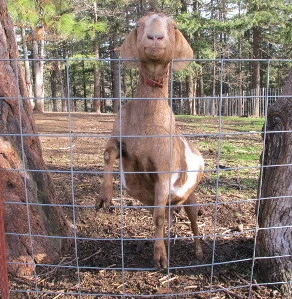Why Goats? (needs pic)

Sparkle shows off her pregnant belly
Creating a sustainable natural burial cemetery involves weaving lots of threads together, some of which are fairly obvious, but some threads need a bit of explanation. Goats are a good example.
The primary permaculture role our goats play involves converting things we can’t eat into the milk, yogurt, and cheese that sustain the people who steward the forest. A secondary role involves groundskeeping as the goats can help control the forest’s understory.
But I believe that there’s a deeper service that Herland’s goats offer, especially the baby goats. The stewards of the Herland Forest provide support for people who need to lay a loved one to rest, and that’s a somber responsibility. We do our best to facilitate an interment that meets their needs, and that’s fine—that’s what we do.
But there’s an emotional impact that comes from being engaged in another person’s sorrow, and that impact needs to be balanced. I find that witnessing the conclusion of one life causes me to take special joy in witnessing the beginning of another life.
Each spring, as life returns to the Herland Forest, baby goats and lambs herald the start of a new season as the cycle of life continues. It’s one thing to know that intellectually, but for me, holding a baby in my arms registers on a much deeper level.
Sparkle is our herd queen and matriarch. You can see from her pic above, that there’s nothing shy about Sparkle. Last year, she birthed quadruplets, and I was able to get some video just after the arrival of the fourth kid. Here’s Sparkle connecting with her new babies.
Weeding the garden isn’t usually a lot of fun, but things shift a bit when goats are involved. No, we don’t trust them to weed the garden themselves, but they are very interested in the weeds that the gardeners “harvest” for them. We could throw the weeds onto the compost pile, but the goats are eager to help us convert the garden’s weeds into rich compost.
Besides, it’s fun to feed the weeds to the goats. They’re so eager to get them—goats will eat hay, if that’s all you’ve got—but they relish weeds. And with hay costing $250 a ton, feeding a selection of fresh greens helps lower costs.
